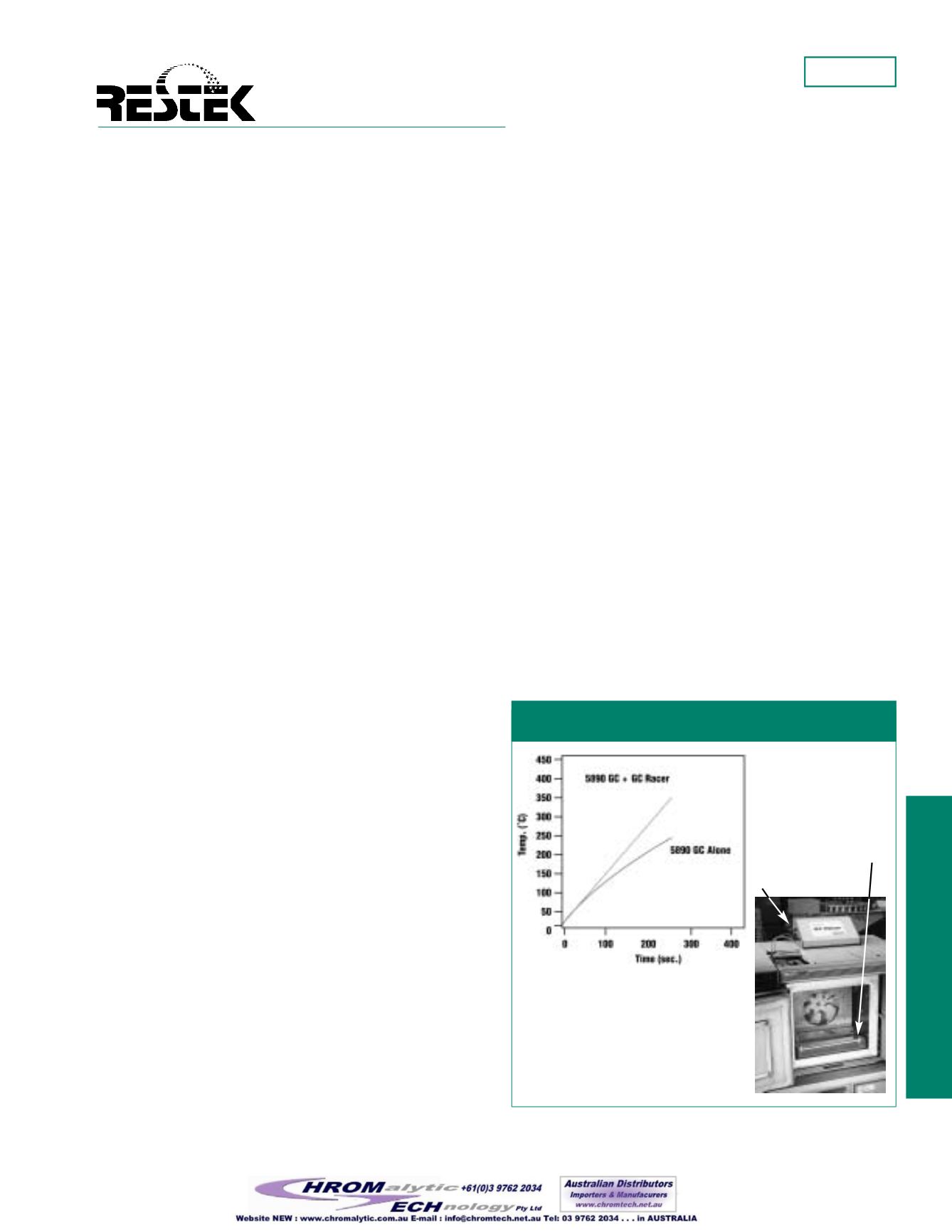
environmental
Applications
note
Restek Corporation • (800) 356-1688 • (814) 353-1300 •
#59457
Fast Analysesof Aroclor
®
PCBs,Using theZipScientificGCRacer*
TemperatureProgrammingSystem
environmental
Introduction
Analytical chemists using traditional gas chromatographs (GC)
have control of four fixed parameters (column length and internal
diameter, phase type and film thickness) and three variable param-
eters (carrier gas composition and velocity, and temperature pro-
gramming) that affect analytical run times. Themaximum oven
temperature ramp rate has been limited, however, based on chro-
matograph design. Now, the temperature-programming rate can be
effectively increased, significantly shortening analysis time for
Aroclor
®
PCBs and thereby reducing instrument operating time
and increasing sample throughput.
Aroclor
®
PCBs
Aroclor
®
mixtures aremixtures of polychlorinated biphenyl (PCB)
congeners, each phenyl ring of which contains 1–5 chlorine atoms.
Since each PCB can contain up to 10 chlorine atoms, in any com-
bination of positions, there are 209 PCB congeners. Environmental
samples are commonly screened for sevenAroclor
®
mixtures that
are or werewidely used, but there are otherAroclor
®
mixtures and
PCBmixtures are alsomanufactured under other tradenames.
The seven commonly analyzedAroclor
®
mixtures areAroclor
®
1016, 1221, 1232, 1242, 1248, 1254, and 1260. OtherAroclor
®
mixtures include “technical”Aroclor
®
1254,Aroclor
®
1262, and
Aroclor
®
1268. TheAroclors
®
containmixes of congeners based on
distillation fractions. The last two digits of theAroclor
®
number
indicate the content of chlorine, byweight (e.g.,Aroclor
®
1232 is
32% chlorine byweight). The exception isAroclor
®
1016, which is
similar toAroclor
®
1242. The range of PCB congeners differs
amongAroclor
®
mixtures (e.g.,Aroclor
®
1242 ismade upmainly
of congeners ranging from approximately dichlorobiphenyls to
tetrachlorobiphenyls; late elutingAroclor
®
1260 ismade upmostly
of hexachlorobiphenyls to octachlorobiphenyls) and, since the
mixturesweremade toweight percent chlorine, not to specific
composition standards, the exact mixture of congeners varies
among variousmanufacture lots.AllAroclor
®
mixtures have some
PCB congeners in common, so retention times amongAroclor
®
mixtures overlap, but eachAroclor
®
mixture has an identifiable fin-
gerprint pattern.
ReducingAnalysisTime
Because the chromatographic patterns of the variousAroclor
®
mix-
tures are easily differentiated, the chromatographer could acceler-
ate theGC analysis, and thereby accomplishmore analyses during
a set period of time. To reduce analysis timewithout changing the
column, the chromatographer has three options: change carrier gas
(from helium to hydrogen), increase the velocity at which the car-
rier gas passes through the column, or increase the oven tempera-
ture program rate.
Changing the carrier gasmight not be a practical option. To
increase the velocity of the carrier gas the backpressure at the col-
umn inlet must be increased. Generally, 30m x 0.32mm columns
are operated at a pressure of 5-10psig, but the pressure can be
increased to 25 psigwithout a loss of column efficiency that would
affectAroclor
®
quantification.
The third option, increasing the oven temperature program rate, has
been a problem until now: oven temperature ramp rates are limited.
Most older chromatographmodels have amaximum reliable pro-
gramming rate of 20°C/minute; newermodels allow programming
rates of up to 70°C/minute, but only to relatively lowmaximum
temperatures.
Now, by using the Zip ScientificGCRacer auxiliary heating unit,
temperature program rates of up to 70°C/min. can bemaintained to
temperatures up to 350°C—conditions that allow analyses of
Aroclor
®
PCBmixtures to be accelerated.
TheGCRacer consists of a program controller and a resistive heat-
ing element that is placed on the floor of theGC oven (Figure 1).
The heating element is connected to the controller which, in turn,
is plugged into themain PC board of theGC.When theGCRacer
programmer detects that the factory heating elements are not keep-
ing upwith the programmed heating rate, theGCRacer heater is
brought into the circuit to augment the heat being supplied to the
oven. Oven temperaturewith andwithout supplementation from a
GCRacer has been empirically testedwith anAgilent 5890 chro-
matograph; results are shown in Figure 1.
Faster Aroclor
®
Analyses
Figure 1—TheGCRacer allows a temperature program
rate of up to 70°C/min. tobemaintainedup to 350°C.
GC:
Agilent 5890;
Service:
120V/15 amp;
Start Temp:
20°C; set oven to 400°C and
monitor oven temp.
The GCRacer consists of a
control unit and a resistive
heating element placed on
the floor of the GC oven.
*Patent pending.
control unit
heating
element


